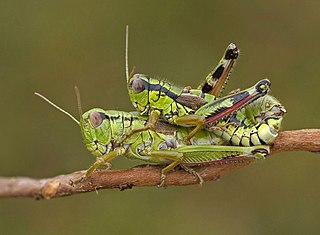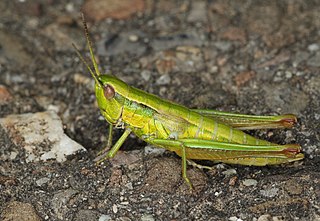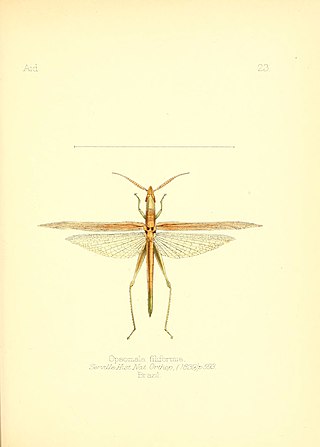
The Melanoplinae are a subfamily of grasshoppers in the family Acrididae. They are distributed across the Holarctic and Neotropical realms. They are one of the two largest subfamilies in the Acrididae. As of 2001 the Melanoplinae contained over 800 species in over 100 genera, with more species being described continuously.

Tetrigidae is an ancient family in the order Orthoptera, which also includes similar families such as crickets, grasshoppers, and their allies. Species within the Tetrigidae are variously called groundhoppers, pygmy grasshoppers, pygmy devils or "grouse locusts".

Acridoidea is the largest superfamily of grasshoppers in the order Orthoptera with over 11,000 species found on every continent except Antarctica.

Gomphocerinae, sometimes called "slant-faced grasshoppers", are a subfamily of grasshoppers found on every continent but Antarctica and Australia.

The Tanaoceridae are an insect family in the monotypic superfamily Tanaoceroidea in the suborder Caelifera. They are sometimes called desert long-horned grasshoppers.

The Trigonopterygoidea are an insect superfamily in the Orthoptera: Caelifera. Sometimes described as leaf grasshoppers, American species in the Xyronotidae have also been called razor-backed bush-hoppers.
The Tristiridae are a family of grasshoppers, in the Orthoptera: suborder Caelifera. Species in this family can be found in the Americas.

Dociostaurus is a genus of grasshoppers in the family Acrididae, subfamily Gomphocerinae and typical of the tribe Dociostaurini. Species are found in Africa, southern Europe and Asia, and includes the economically important Moroccan locust.

Romaleinae is a subfamily of lubber grasshoppers in the family Romaleidae, found in North and South America. More than 60 genera and 260 described species are placed in the Romaleinae.

Orthacris is a genus of grasshoppers in the family Pyrgomorphidae and the subfamily Orthacridinae. Species are found in the Indian subcontinent including Sri Lanka.

The Orthacridinae are a sub-family of grasshoppers in the family Pyrgomorphidae. Species are found in: Central America, Africa, Asia, Australia and certain Pacific Islands. The type genus is Orthacris and the taxon proposed by Bolívar in 1905.

Leptysminae is a subfamily of spur-throat toothpick grasshoppers in the family Acrididae. There are at least 20 genera in Leptysminae, found in North, Central, and South America.

Erucius is a genus of "monkey grasshoppers" in the family Chorotypidae. Species in this genus can be found in Vietnam and Malesia, including the Philippines. It is the only genus in the subfamily Eruciinae.
Erucius magnificus is a species of 'monkey grasshopper' in the family Chorotypidae, with no subspecies listed in the Catalogue of Life. The type locality was in Borneo and current records also include Vietnam.
Coptacra is the type genus of grasshoppers in the subfamily Coptacrinae. Species can be found in tropical Asia.
Coptotettix is a genus of Asian groundhoppers, now placed incertae sedis in the family Tetrigidae; it was erected by Ignacio Bolívar in 1887.

Ronderosia is a genus of spur-throated grasshoppers in the family Acrididae. There are about 10 described species in Ronderosia, found in South America.

Stenopola is a genus of spur-throat toothpick grasshoppers in the family Acrididae. There are about 13 described species in Stenopola, found in the Americas.

The Ommatolampidinae are a subfamily of grasshoppers in the family Acrididae, found in central and South America, and based on the type genus Ommatolampis. Derived from the "Ommatolampides" used by Brunner von Wattenwyl in 1893, the first use of the name in its current form was by Rodríguez et al. in 2013; this taxon appears to be paraphyletic.














